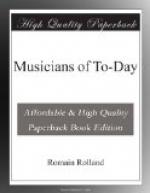“Classical music was so little known to the musical public that even the audiences of La Trompette, cultured as they were, did not at all understand Beethoven’s last quartettes; and my friends jeered at my taste for enigmas. This only made me the more determined that they should hear one of these great works at each concert. And sometimes I would give the same work at two or three concerts running if I thought it had not been properly appreciated. In that case I used to say before the performance: ’It seems to me that such-and-such a work has not been quite understood at the last hearing; and as it is a really marvellous work, I am sure that your feeling is that you do not know it sufficiently. So I have included it in to-day’s programme.’"[237]
[Footnote 237: The name, La Trompette, was also the pretext for embellishing chamber-music, by introducing the trumpet among the other instruments. To this end M. Saint-Saens wrote his fine septette for piano, trumpet, two violins, viola, violoncello, and double bass; and M. Vincent d’Indy his romantic suite in D for trumpet, two flutes, and string instruments.]
These performances of sonatas, trios, and quartettes, were attentively listened to by an audience of five or six hundred persons, the greater part of them cultured people, students from the poly-technics and universities, who formed the kernel of a very discerning and enthusiastic public for chamber-music.
By degrees, following the example of Emile Lemoine, other quartette societies were formed; and at present they are so numerous that it would be difficult to name them all. And then there sprang up the same spirit of intelligent curiosity that had induced the French Kapellmeister of the symphony concert societies sometimes to introduce their German and Russian colleagues as conductors; and for this purpose the Nouvelle Societe Philharmonique de Paris was founded, in 1901, on the initiative of Dr. Fraenkel and under the direction of M. Emmanuel Rey, to give a hearing in Paris to the principal foreign quartette players. And the profit was as great in one case as in the other; and the friendly rivalry between French quartette players and those of other countries bore good fruit, and gave us a fuller understanding of the inner character of German music.
* * * * *
5. Musical Learning and the University
While this movement was going on in the artistic world, scholars were taking their share in it, and music was beginning to invade the University.
But the thing was brought about with some difficulty; for among these serious people music did not count as a serious study. Music was thought of as an agreeable art, a social accomplishment, and the idea of making it the subject of scientific teaching must have been received with some amusement. Even up to the present time, general histories of Art have refused to accord music a place, so little was thought of it; and other arts were indignant at being mentioned in the same breath with it. This is illustrated in the eternal dispute among M. Jourdain’s masters, when the fencing-master says:




